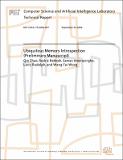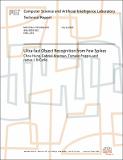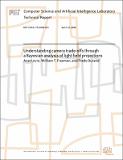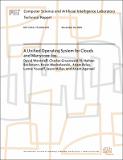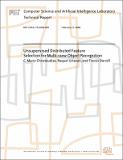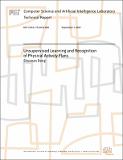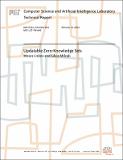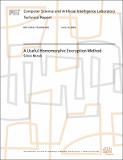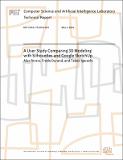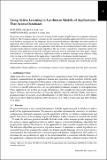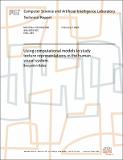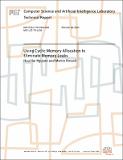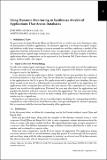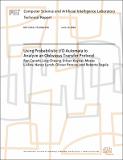Browsing CSAIL Technical Reports (July 1, 2003 - present) by Title
Now showing items 724-743 of 775
-
Ubiquitous Memory Introspection (Preliminary Manuscript)
(2006-09-25)Modern memory systems play a critical role in the performance ofapplications, but a detailed understanding of the application behaviorin the memory system is not trivial to attain. It requires timeconsuming simulations of ... -
Ultra-fast Object Recognition from Few Spikes
(2005-07-06)Understanding the complex brain computations leading to object recognition requires quantitatively characterizing the information represented in inferior temporal cortex (IT), the highest stage of the primate visual stream. ... -
Understanding and evaluating blind deconvolution algorithms
(2009-03-31)Blind deconvolution is the recovery of a sharp version of a blurred image when the blur kernel is unknown. Recent algorithms have afforded dramatic progress, yet many aspects of the problem remain challenging and hard to ... -
Understanding and Supporting Directed Content Sharing on the Web
(2009-10-07)To find interesting, personally relevant web content, we often rely on friends and colleagues to pass links along as they encounter them. In this paper, we study and augment link-sharing via e-mail, the most popular means ... -
Understanding camera trade-offs through a Bayesian analysis of light field projections
(2008-04-16)Computer vision has traditionally focused on extracting structure,such as depth, from images acquired using thin-lens or pinhole optics. The development of computational imaging is broadening this scope; a variety of ... -
Understanding camera trade-offs through a Bayesian analysis of light field projections - A revision
(2008-07-28)Computer vision has traditionally focused on extracting structure,such as depth, from images acquired using thin-lens or pinholeoptics. The development of computational imaging is broadening thisscope; a variety of ... -
A Unified Operating System for Clouds and Manycore: fos
(2009-11-20)Single chip processors with thousands of cores will be available in the next ten years and clouds of multicore processors afford the operating system designer thousands of cores today. Constructing operating systems for ... -
Universal Motion Generator: Trajectory Autocompletion by Motion Prompts
(2022-06-15)Foundation models, which are large neural networks trained on massive datasets, have shown impressive generalization in both the language and the vision domain. While fine-tuning foundation models for new tasks at test-time ... -
Unsupervised Distributed Feature Selection for Multi-view Object Recognition
(2008-02-17)Object recognition accuracy can be improved when information frommultiple views is integrated, but information in each view can oftenbe highly redundant. We consider the problem of distributed objectrecognition or indexing ... -
Unsupervised Learning and Recognition of Physical Activity Plans
(2007-08-23)This thesis desires to enable a new kind of interaction between humans and computational agents, such as robots or computers, by allowing the agent to anticipate and adapt to human intent. In the future, more robots may ... -
Updatable Zero-Knowledge Sets
(2003-10-14)We build on the work of Micali, Rabin, and Killian [4] to introduce zero-knowledge sets and databases that may be updated in a desirable way. In particular, in order to make an update the owner of the set must publish a ... -
A Useful Homomorphic Encryption Method
(2009-06-15) -
A User Study Comparing 3D Modeling with Silhouettes and Google SketchUp
(2010-05-05)We describe a user study comparing 3D Modeling with Silhouettes and Google SketchUp. In the user study, ten users were asked to create 3D models of three different objects, using either 3D Modeling with Silhouettes or ... -
Using Active Learning to Synthesize Models of Applications That Access Databases
(2018-08-28)We present a new technique that uses active learning to infer models of applications that manipulate relational databases. This technique comprises a domain-specific language for modeling applications that access ... -
Using Code Perforation to Improve Performance, Reduce Energy Consumption, and Respond to Failures
(2009-09-03)Many modern computations (such as video and audio encoders, Monte Carlo simulations, and machine learning algorithms) are designed to trade off accuracy in return for increased performance. To date, such computations ... -
Using computational models to study texture representations in the human visual system.
(2005-02-07)Traditionally, human texture perception has been studied using artificial textures made of random-dot patterns or abstract structured elements. At the same time, computer algorithms for the synthesis of natural textures ... -
Using Cyclic Memory Allocation to Eliminate Memory Leaks
(2005-10-26)We present and evaluate a new memory management technique foreliminating memory leaks in programs with dynamic memoryallocation. This technique observes the execution of the program on asequence of training inputsto find ... -
Using Dynamic Monitoring to Synthesize Models of Applications That Access Databases
(2018-09-27)We previously developed Konure, a tool that uses active learning to infer the functionality of database applications. An alternative approach is to observe the inputs, outputs, and database traffic from a running ... -
Using Probabilistic I/O Automata to Analyze an Oblivious Transfer Protocol
(2006-06-19)We demonstrate how to carry out cryptographic security analysis ofdistributed protocols within the Probabilistic I/O Automataframework of Lynch, Segala, and Vaandrager. This framework providestools for arguing rigorously ... -
Using Probabilistic I/O Automata to Analyze an Oblivious Transfer Protocol
(2005-08-19)We demonstrate how to carry out cryptographic security analysis ofdistributed protocols within the Probabilistic I/O Automata frameworkof Lynch, Segala, and Vaandrager.This framework provides tools for arguing rigorously ...
